

Gadolinium. Gadolinium is a chemical element with symbol Gd and atomic number 64.
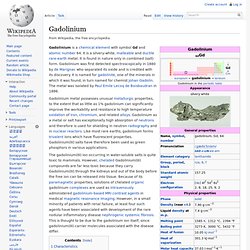
It is a silvery-white, malleable and ductile rare-earth metal. It is found in nature only in combined (salt) form. Phase transiting to a new quantum universe. (Phys.org) —Recent insight and discovery of a new class of quantum transition opens the way for a whole new subfield of materials physics and quantum technologies.

This week an article in Nature Physics reports the results on quantum properties of ferroelectric crystals, led by Stephen Rowley, together with Siddharth Saxena and Gilbert Lonzarich of the Cavendish Laboratory. Europium’s superconductivity demonstrated. Skip to comments.

Europium’s superconductivity demonstrated Science News ^ | May 20th, 2009 | Laura Sanders Posted on Sun May 24 10:18:54 2009 by neverdem The rare earth metal is the 53rd naturally occurring element to possess the property. La lévitation des supraconducteurs : l’effet Meissner. Elusive Dark Matter May Have Already Been Found. The mysterious dark matter that makes up most of the matter in the universe may already have been detected with superconducting circuits, researchers say.
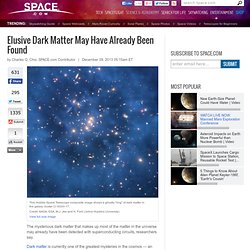
Dark matter is currently one of the greatest mysteries in the cosmos — an invisible substance thought to make up five-sixths of all matter in the universe. The scientific consensus right now is that dark matter is composed of a new type of particle, one that interacts very weakly at best with all the known forces of the universe, except gravity. As such, dark matter is invisible and nearly completely intangible, mostly only detectable via the gravitational pull it exerts. How Metamaterials Could Hold the Key to High Temperature Superconductivity. Metamaterials are one of the wonders of modern physics.

Made using repeating 3D patterns of electronic components such as capacitors and resistors, metamaterials interact with light waves, steering them in ways that are impossible with ordinary stuff. The result: more invisibility cloaks than you can shake a wand at. But there is no magic at work. The general theory that explains this is known as transformation optics. And the mathematics behind it is formally analogous to the equations that describe how mass warps spacetime to generate gravity.
Now Igor Smolyaninov and Vera Smolyaninova at the University of Maryland in College Park say metamaterials may be formally linked to another area of physics: superconductivity. First, some background. For many years after the discovery of superconductivity in 1911, physicists were puzzled about how it arose. Their idea is that at low temperatures, electrons double up to form Cooper pairs which travel through the material lattice together. Ordinateur quantique : un temps de décohérence record de 39 minutes.
Le prix Nobel de physique Richard Feynman s'est intéressé à la réalisation d'ordinateurs quantiques au début des années 1980.
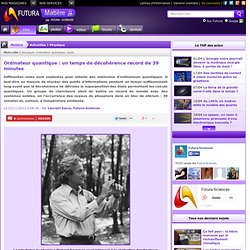
Il est considéré comme un des pionniers de ce domaine. © Tamiko Thiel, Wikimedia Commons, cc by sa 3.0 Ordinateur quantique : un temps de décohérence record de 39 minutes - 1 Photo. Scientists create never-before-seen form of matter. Harvard and MIT scientists are challenging the conventional wisdom about light, and they didn't need to go to a galaxy far, far away to do it.

Working with colleagues at the Harvard-MIT Center for Ultracold Atoms, a group led by Harvard Professor of Physics Mikhail Lukin and MIT Professor of Physics Vladan Vuletic have managed to coax photons into binding together to form molecules – a state of matter that, until recently, had been purely theoretical. The work is described in a September 25 paper in Nature. The discovery, Lukin said, runs contrary to decades of accepted wisdom about the nature of light. Photons have long been described as massless particles which don't interact with each other – shine two laser beams at each other, he said, and they simply pass through one another. "Photonic molecules," however, behave less like traditional lasers and more like something you might find in science fiction – the light saber. The reason they form the never-before-seen molecules?
Vortex pinning could lead to superconducting breakthroughs. A team of researchers from Russia, Spain, Belgium, the U.K. and the U.S.

Department of Energy's (DOE) Argonne National Laboratory announced findings last week that may represent a breakthrough in applications of superconductivity. The team discovered a way to efficiently stabilize tiny magnetic vortices that interfere with superconductivity—a problem that has plagued scientists trying to engineer real-world applications for decades. The discovery could remove one of the most significant roadblocks to advances in superconductor technology. Superconductors are extremely useful materials, given that modern society involves moving a lot of electricity around.
Each time we do it, whether it be along the cord from the outlet to your lamp or in the millions of miles of power lines strung across the country, we lose a little bit of electricity. But in an ideal superconductor, no electricity is ever lost. The problem is that superconductors have to be cooled to do their thing. Spin. Spin is the amount of rotation an object has, taking into account its mass and shape.
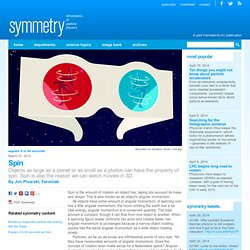
This is also known as an object’s angular momentum. All objects have some amount of angular momentum. A spinning coin has a little angular momentum; the moon orbiting the earth has a lot. Like energy, angular momentum is a conserved quantity: The total amount is constant, though it can flow from one object to another. When a spinning figure skater contracts her arms and rotates faster, her angular momentum is unchanged because a narrow object rotating quickly has the same angular momentum as a wide object rotating slowly. Particles, as far as we know, are infinitesimal points of zero size. The angular momentum, or spin, of a single particle is restricted in strange ways.
Though particle spins are tiny, they have an impact on our everyday world. Martin vam Exter's Research. Spin. Un article de Wikipédia, l'encyclopédie libre.
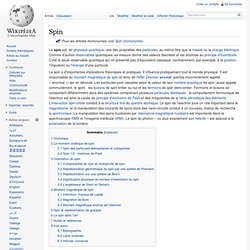
Le spin est, en physique quantique, une des propriétés des particules, au même titre que la masse ou la charge électrique. Comme d'autres observables quantiques, sa mesure donne des valeurs discrètes et est soumise au principe d'incertitude. C'est la seule observable quantique qui ne présente pas d'équivalent classique, contrairement, par exemple, à la position, l'impulsion ou l'énergie d'une particule. Paradoxe EPR. Intrication quantique. Un article de Wikipédia, l'encyclopédie libre. Historique[modifier | modifier le code] Le caractère surprenant des états intriqués a pour la première fois été souligné par Einstein, Podolsky et Rosen dans un article de 1935 qui tentait de montrer que la mécanique quantique était incomplète.
Dans cet article, les auteurs décrivent une expérience de pensée qui restera connue comme le paradoxe EPR. Définition[modifier | modifier le code] Il est plus aisé de définir ce qu'est un état non intriqué, ou séparable, que de définir directement ce qu'est un état intriqué. État pur[modifier | modifier le code] Vortex Fountain. Vortex annihilation. Le Nobel de physique à un Français et à un Américain.
Le jury les récompense pour «leurs méthodes expérimentales novatrices qui permettent la mesure et la manipulation des systèmes quantiques individuels». «Les lauréats ont ouvert la voie à une nouvelle ère d'expérimentation dans la physique quantique en démontrant l'observation directe de particules quantiques individuelles sans les détruire», précise le communiqué de l'Académie royale des Sciences de Suède. Serge Haroche, 68 ans, avec son collègue de l'École normale supérieure (ENS) Jean-Michel Raimond, a en 2008 réussi à observer le passage du quantique à la physique classique sur un petit paquet de photons, des grains de lumière.
Pour cette expérience, ils ont utilisé un dispositif (une cavité tapissée de miroirs), capable de piéger pendant très longtemps des photons, ainsi qu'une méthode d'observation des photons qui ne les perturbe que très peu. Les prix Nobel de physique depuis 1975: -1982: Kenneth Wilson (USA) pour avoir développé la théorie des transitions -Avec Associated Press. Vitesse supraluminique. Www.bourbaphy.fr/duplantier.pdf.